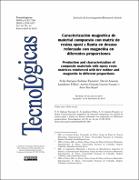Mostrar el registro sencillo del ítem
Caracterización magnética de material compuesto con matriz de resina epoxi y llanta en desuso reforzado con magnetita en diferentes proporciones
| dc.contributor.author | Salinas Tacumá, Felix Enrique | |
| dc.contributor.author | Landinez Téllez, David Arsenio | |
| dc.contributor.author | Garzón Posada, Andrés Orlando | |
| dc.contributor.author | Roa Rojas, Jairo | |
| dc.date.accessioned | 2019-07-18T14:13:20Z | |
| dc.date.accessioned | 2019-08-22T14:22:49Z | |
| dc.date.available | 2019-07-18T14:13:20Z | |
| dc.date.available | 2019-08-22T14:22:49Z | |
| dc.date.issued | 2019-01-15 | |
| dc.identifier | https://revistas.itm.edu.co/index.php/tecnologicas/article/view/999 | |
| dc.identifier | 10.22430/22565337.999 | |
| dc.identifier.uri | http://hdl.handle.net/20.500.12622/1077 | |
| dc.description.abstract | Este trabajo describe la producción y caracterización magnética de un compuesto a base de resina epoxi y caucho pulverizado reforzado con magnetita (𝐹𝑒3𝑂4) en polvo. Además, se presenta el análisis realizado a los compuestos en función de la carga magnética dentro de la matriz polimérica. Las propiedades magnéticas del material se realizaron a diferentes temperaturas en un rango magnético de -30000 a 30000 0e. La morfología tanto de los precursores como de los compuestos fue determinada por microscopía electrónica de barrido (MEB) y la caracterización estructural fue realizada por difracción de rayos X (DRX). El patrón de difracción obtenido en las mediciones de DRX permite observar que, con la adición de magnetita en polvo en la matriz plástica, se crea una transición amorfo-cristalina en el material. A través de las imágenes obtenidas por MEB se observa la presencia de hematita en el precursor (𝐹𝑒3𝑂4) y un tamaño irregular en las muestras. Los compuestos se comportan como un material magnético blando y presenta cambios en la variación de la fuerza coercitiva, tanto con el incremento de temperatura como con la variación de porcentaje de volumen de magnetita en la matriz polimérica. El material fabricado puede ser utilizado en aplicaciones donde el compuesto debe ser fácilmente detectable. | spa |
| dc.format.mimetype | application/pdf | |
| dc.format.mimetype | text/xml | |
| dc.language.iso | spa | |
| dc.language.iso | eng | |
| dc.publisher | Instituto Tecnológico Metropolitano (ITM) | spa |
| dc.relation | https://revistas.itm.edu.co/index.php/tecnologicas/article/view/999/1173 | |
| dc.relation | https://revistas.itm.edu.co/index.php/tecnologicas/article/view/999/1227 | |
| dc.relation | https://revistas.itm.edu.co/index.php/tecnologicas/article/view/999/1275 | |
| dc.rights | Copyright (c) 2019 TecnoLógicas | spa |
| dc.rights | https://creativecommons.org/licenses/by-nc-sa/4.0 | spa |
| dc.source | 2256-5337 | |
| dc.source | 0123-7799 | |
| dc.source | TecnoLógicas; Vol 22 No 44 (2019); 81-95 | eng |
| dc.source | TecnoLógicas; Vol. 22 Núm. 44 (2019); 81-95 | spa |
| dc.subject | Desechos de llantas | spa |
| dc.subject | ferrimagnético | spa |
| dc.subject | materiales compuestos | spa |
| dc.subject | magnetita | spa |
| dc.subject | resina epoxi | spa |
| dc.title | Caracterización magnética de material compuesto con matriz de resina epoxi y llanta en desuso reforzado con magnetita en diferentes proporciones | spa |
| dc.title.alternative | Production and characterization of composite materials with epoxy resin matrices reinforced with tire rubber and magnetite in different proportions | |
| dc.subject.keywords | Epoxy resin | eng |
| dc.subject.keywords | ferrimagnetic | eng |
| dc.subject.keywords | magnetite | eng |
| dc.subject.keywords | composite materials | eng |
| dc.subject.keywords | waster tire | eng |
| dc.type | info:eu-repo/semantics/article | |
| dc.type | info:eu-repo/semantics/publishedVersion | |
| dc.type | Research Papers | eng |
| dc.type | Artículos de investigación | spa |
| dc.relation.ispartofjournal | TecnoLógicas | |
| dc.description.abstractenglish | This work describes the production and magnetic characterization of a compound base on epoxy resin and powdered rubber reinforced with magnetite (𝐹𝑒3𝑂4) poder. Also it is presented the análisis carried out on the components, which are according to the magnetic charging inside the polymeric matrix. the magnetic properties of the material they were made at different temperaturas in a magnetic range from -30000 to 30000 Oe the morphology of both the precursons like the compounds was determined by scanning electron microscopy and structural characterizatin was performed by X- ray diffraction (XRD). The diffraction pattern obtained in the XRD measurements allows us to observe that, with the addition of powdered magnetite in the plastic matrix, an amorphous-crystalline transition is created in the material.Through the images obtained by SEM, the presence of hematite in the precursor (𝐹𝑒3𝑂4) and irregular size in the samples is observed. The compounds behave like a soft magnetic material and present changes in the variation of the coercive force, both with the increase in temperature and with the percentage variation of magnetite volume in the polymer matrix. The manufactured material can be used in applications where the compound should be easily detectable. | eng |
| dc.rights.accessrights | info:eu-repo/semantics/openAccess | |
| dc.type.coar | http://purl.org/coar/resource_type/c_6501 |


